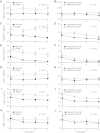Biomarkers of early sepsis may be correlated with outcome
- PMID: 24886652
- PMCID: PMC4039051
- DOI: 10.1186/1479-5876-12-146
Biomarkers of early sepsis may be correlated with outcome
Abstract
Background: Sepsis causes high mortality, and the mortality due to secondary infections is even higher. No studies to date have investigated the time from the primary infection to death due to a secondary infection; similarly, the factors that are significantly different in sepsis survivors relative to non-survivors or in severe sepsis patients who suffered a late death relative to those who recover have not been explored. We hypothesized that patients who survive sepsis have a weaker pro-inflammatory response than those who do not and that the mid-term survivors (which acquire secondary infections) would have a pronounced anti-inflammatory response (making them susceptible to infection); this hypothesis was verified in this study.
Methods: We examined 24 patients with severe sepsis; the patients were subdivided by outcome into early death (n=5), mid-term survival (survival through severe sepsis but death within six months or continued hospitalization for six months, n=6), and long-term survival (recovery and survival for more than six months, n=13) groups. The levels of CD3+, CD4+, CD8+, and CD19+ lymphocytes were analyzed by flow cytometry, and the plasma levels of carbonic anhydrase IX (CA IX), MCP-1, IL-6, IL-7, IL-8, and IL-10 were measured by ELISA on days 0, 1, 2, and 3. A statistical comparison of the variables in the groups was conducted using a mixed model.
Results: The plasma levels of MCP-1, IL-6, and IL-8 in early death and survivors were significantly different, and all had p values<0.01. The plasma levels of MCP-1, IL-6, and IL-8 were also significantly different in mid-term survivors and long-term survivors, with p values of <0.01, 0.04, and <0.01, respectively.
Conclusions: Our data support the hypothesis that survivors have a weaker pro-inflammatory response than non-survivors, but the mid-term survivors did not have a more pronounced anti-inflammatory response. The levels of pro-inflammatory cytokines in the mid-term and long-term survivors were significantly different.
Figures



References
-
- Suffredini AF, Munford RS. Novel therapies for septic shock over the past 4 decades. JAMA. 2011;306:194–199. - PubMed
-
- Vincent JL, Sakr Y, Sprung CL, Ranieri VM, Reinhart K, Gerlach H, Moreno R, Carlet J, Le Gall JR, Payen D. Sepsis Occurrence in Acutely III Patients Investigators. Sepsis in European intensive care units: results of the SOAP study. Crit Care Med. 2006;34:344–353. doi: 10.1097/01.CCM.0000194725.48928.3A. - DOI - PubMed
Publication types
MeSH terms
Substances
LinkOut - more resources
Full Text Sources
Other Literature Sources
Medical
Research Materials
Miscellaneous

